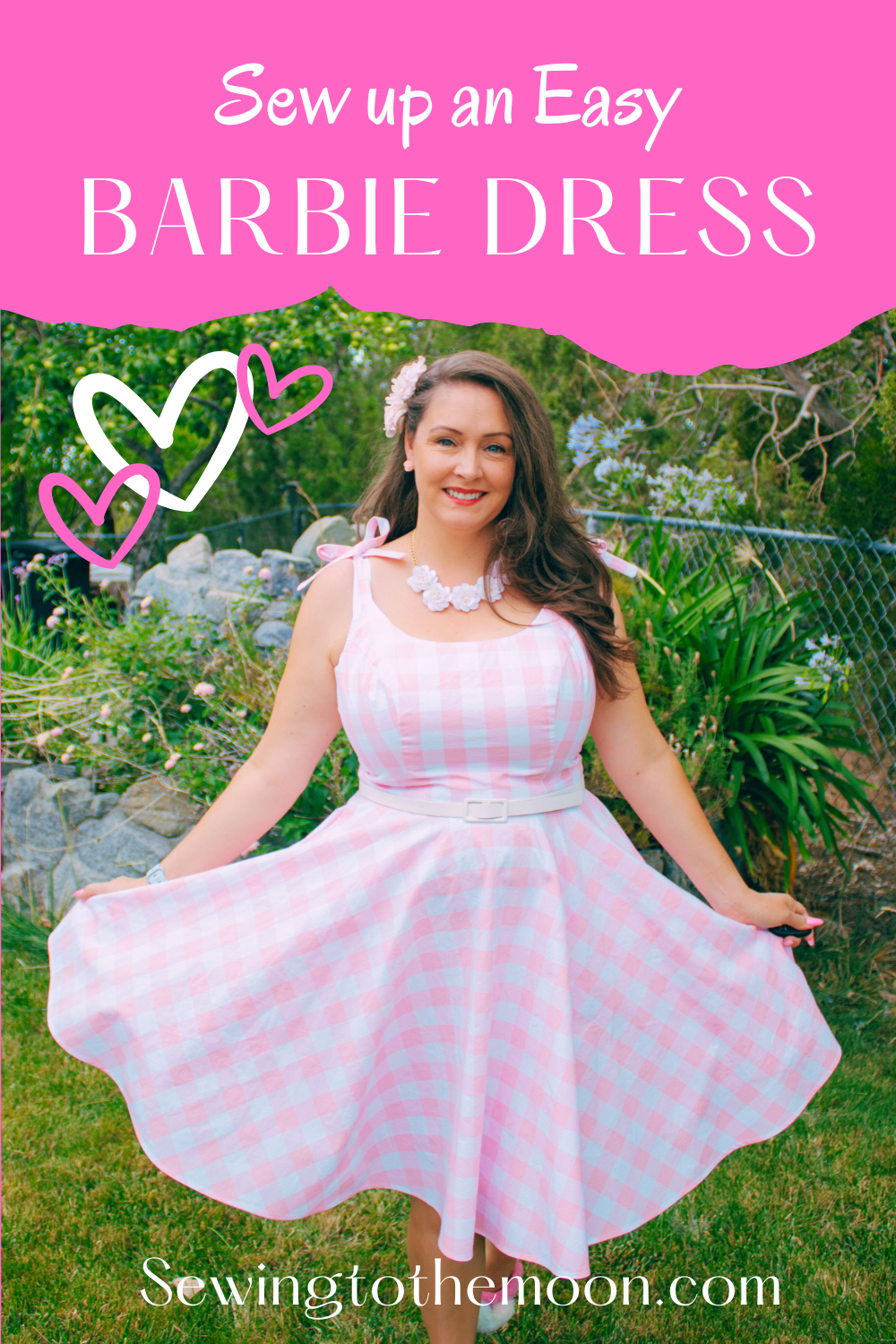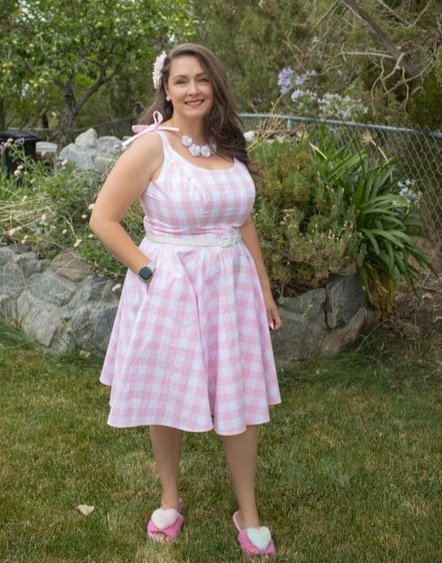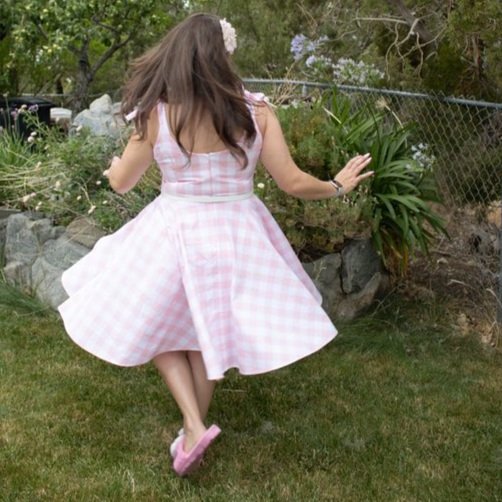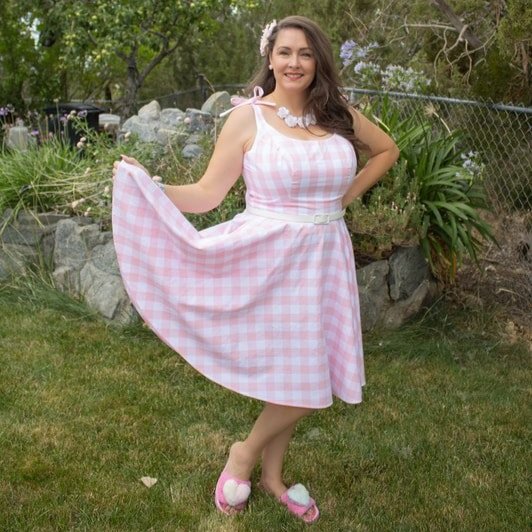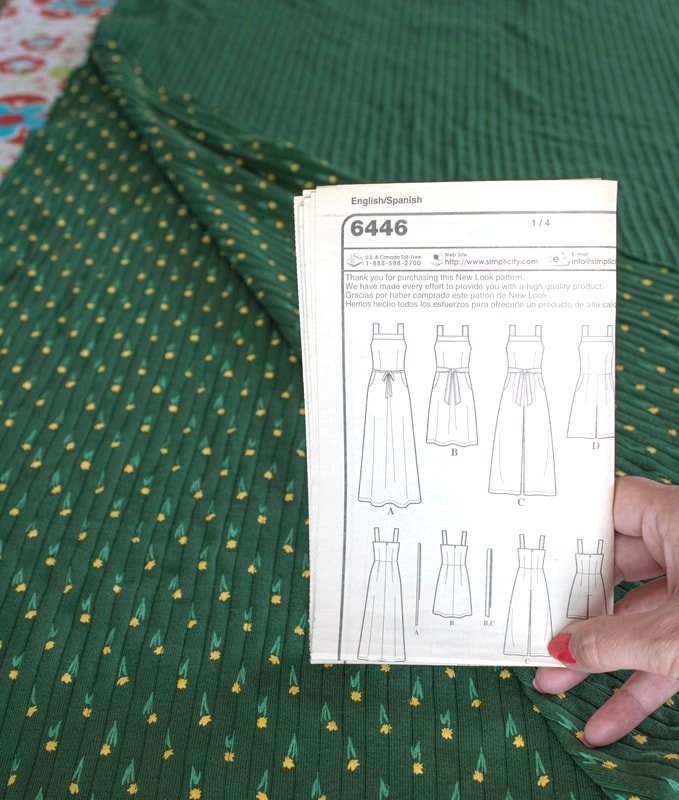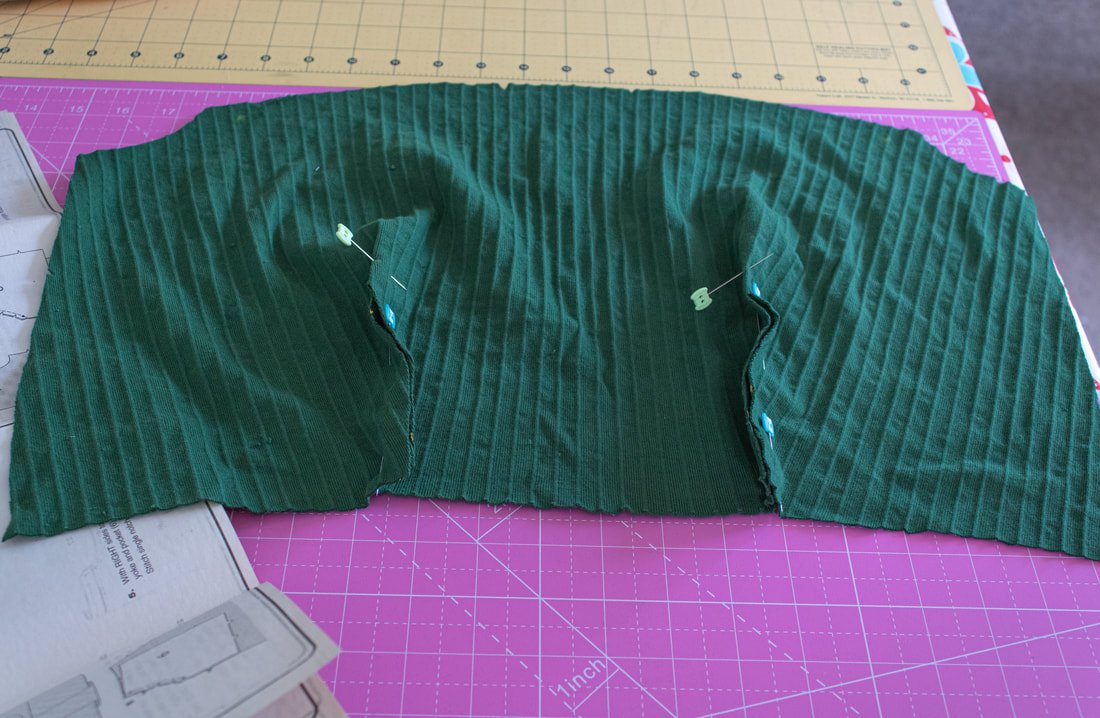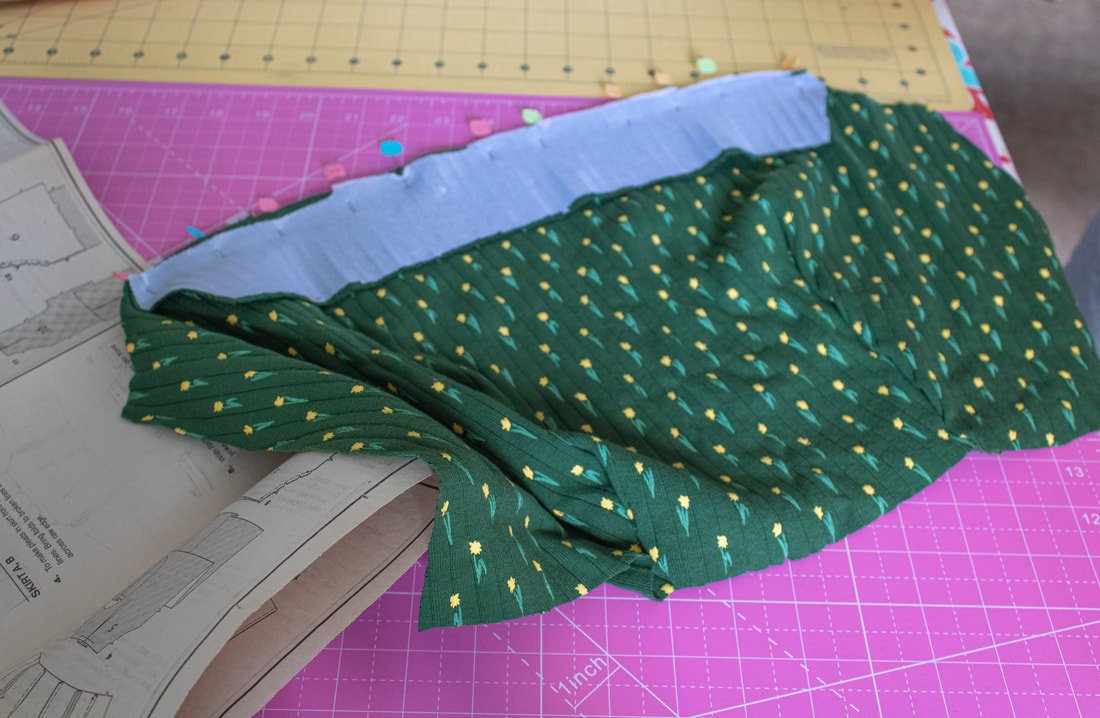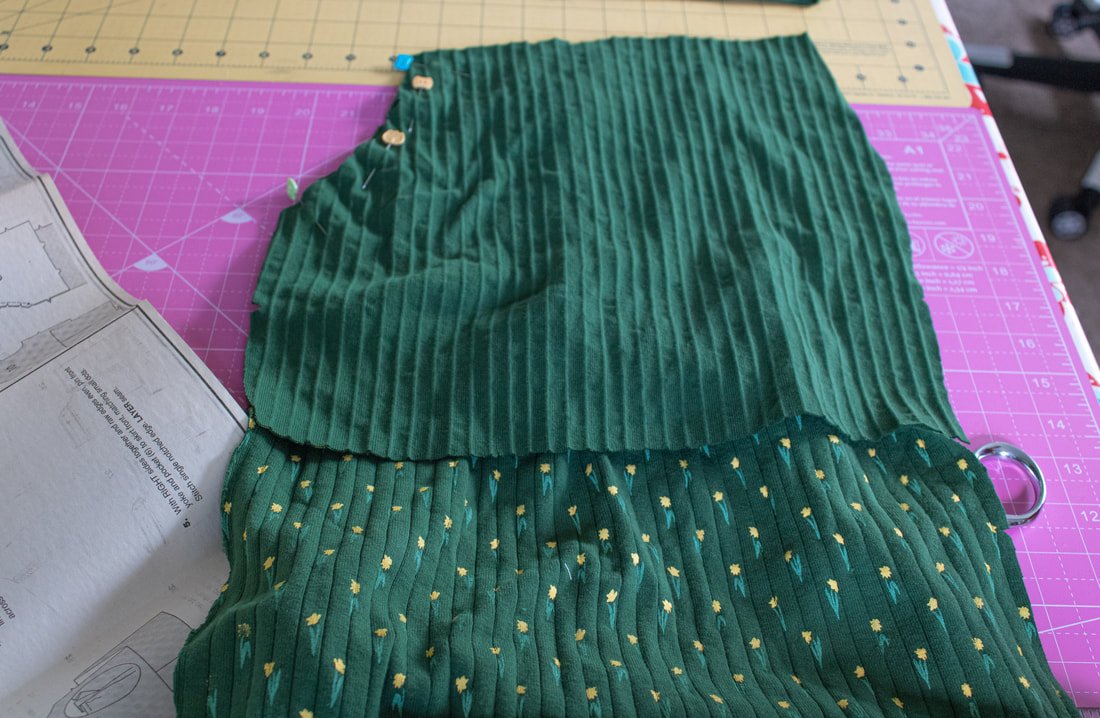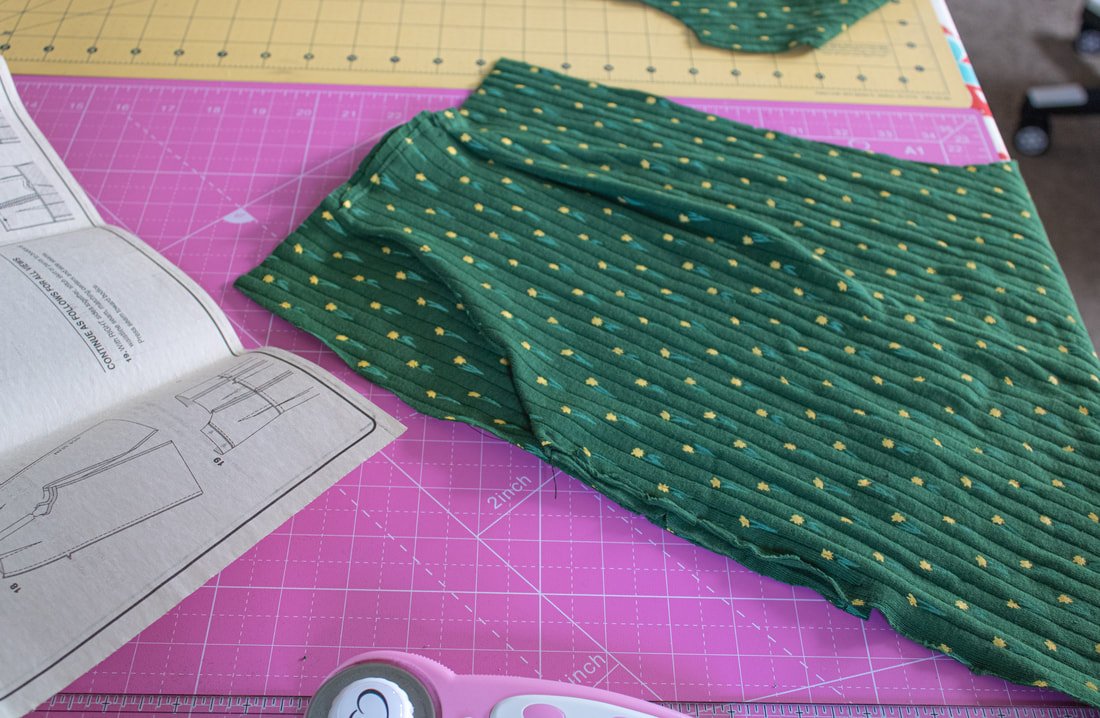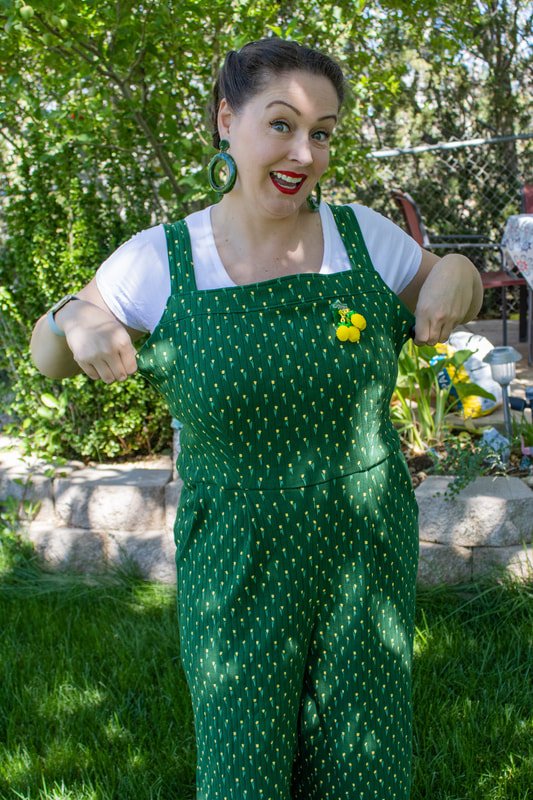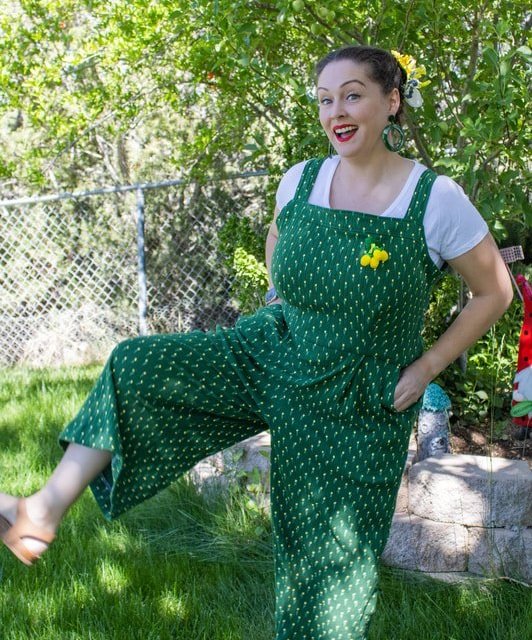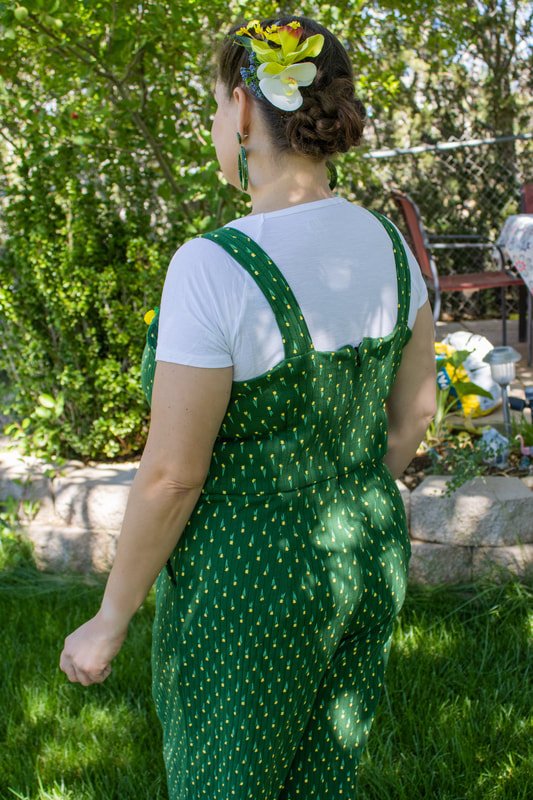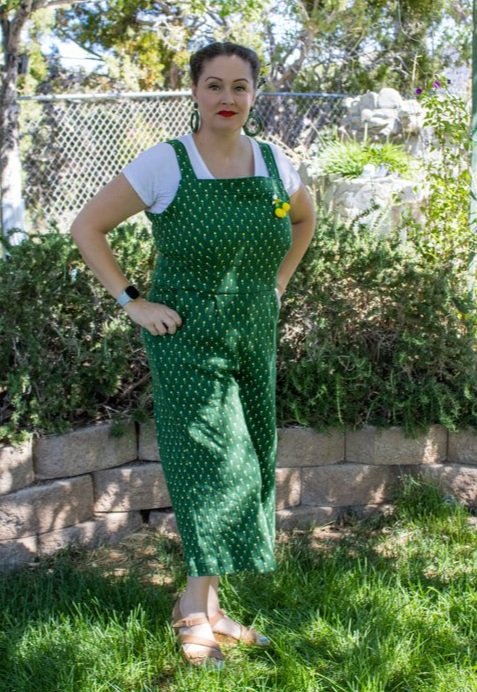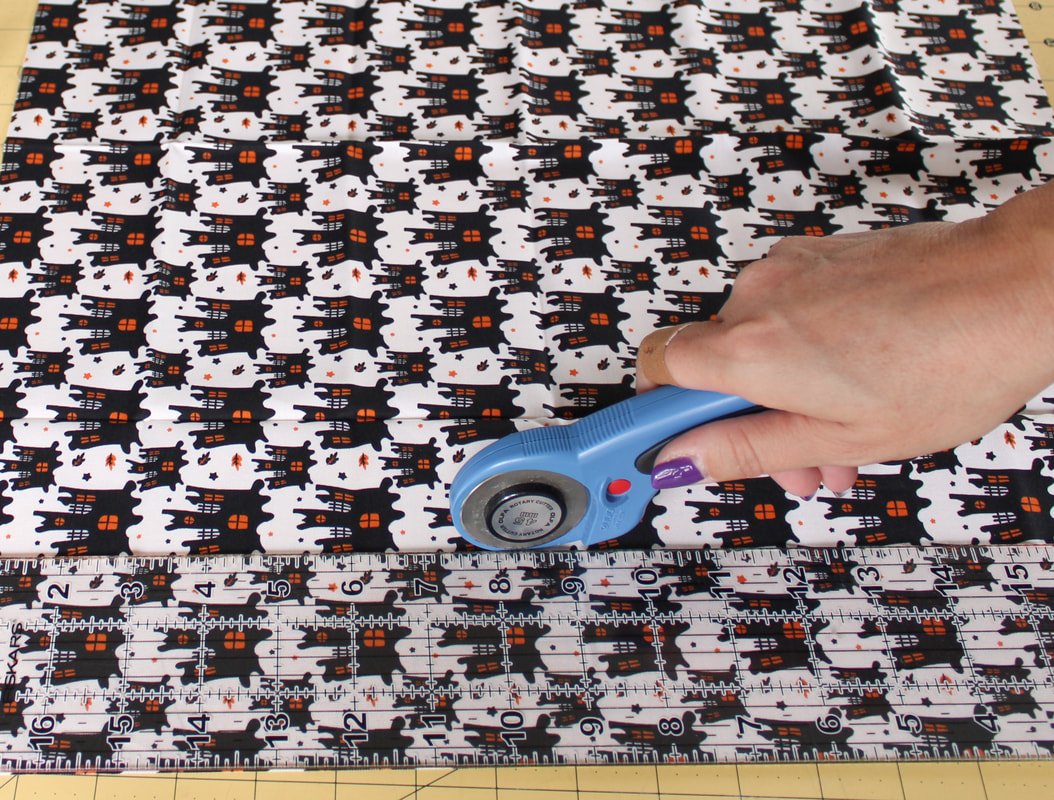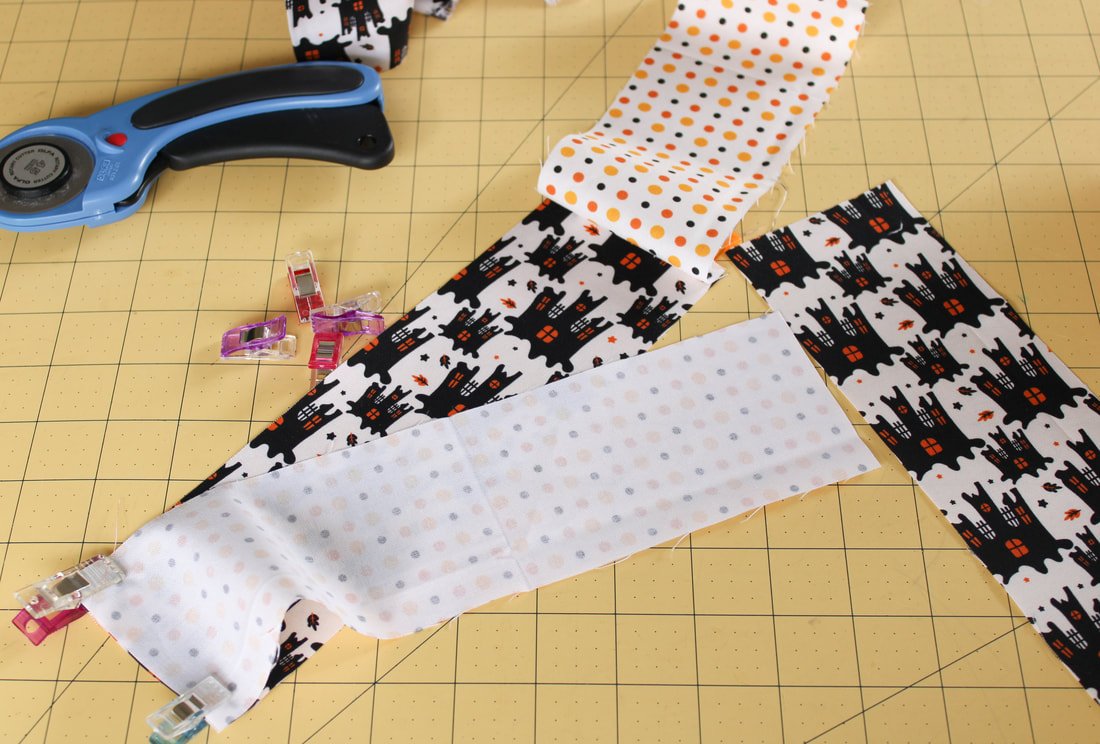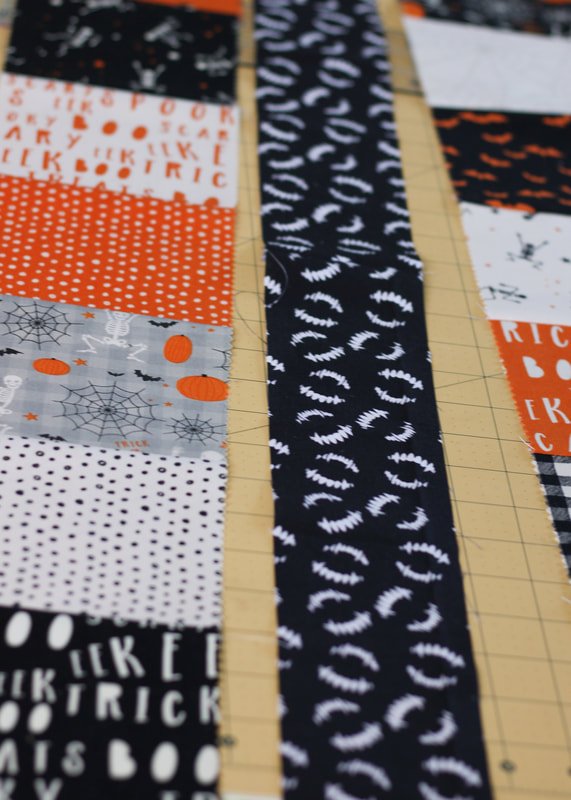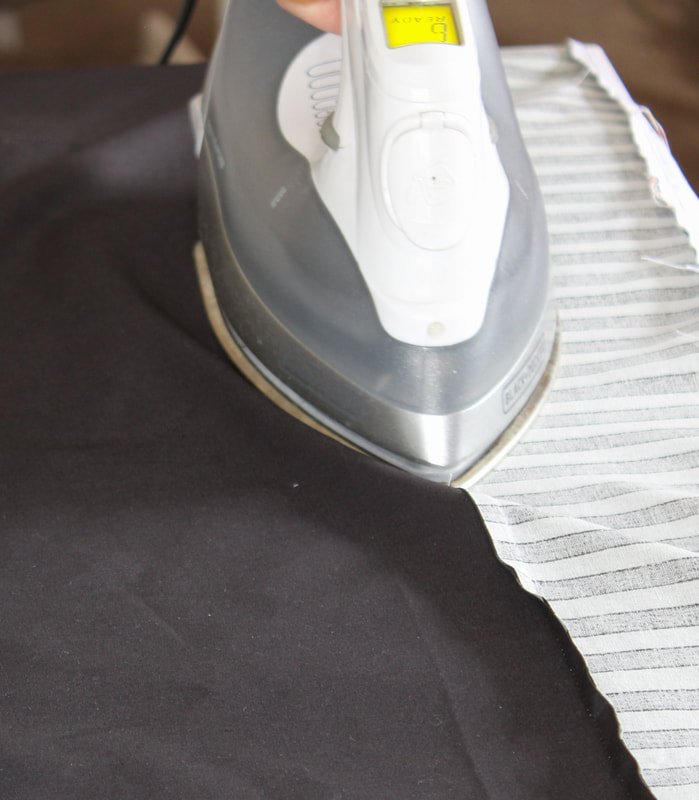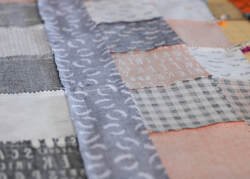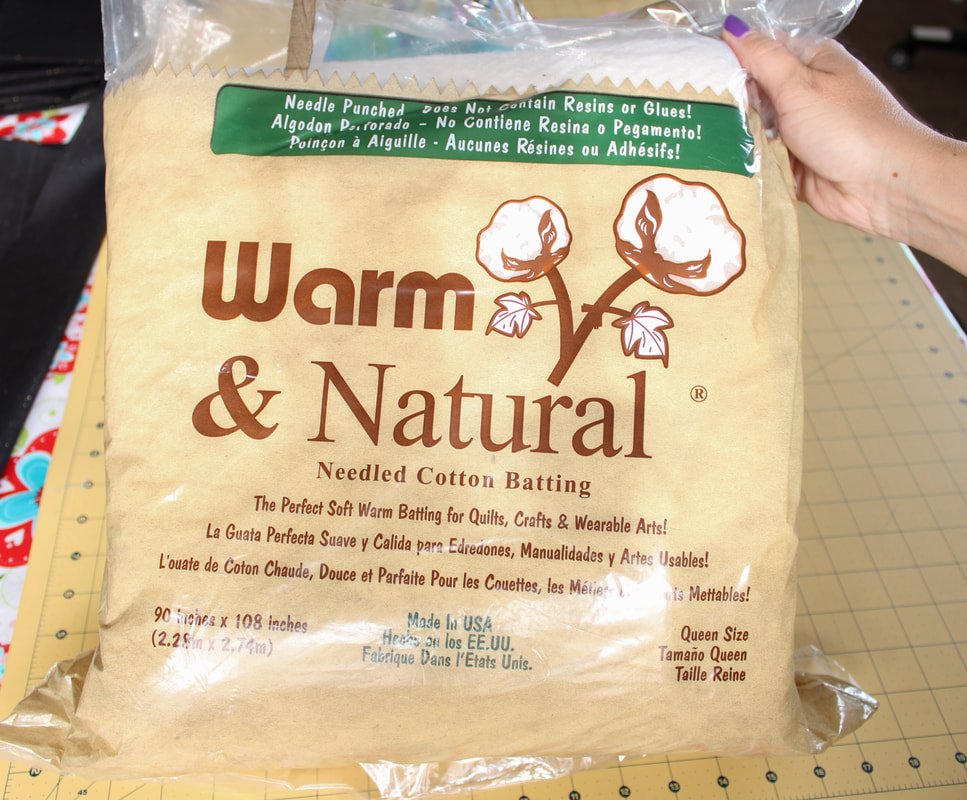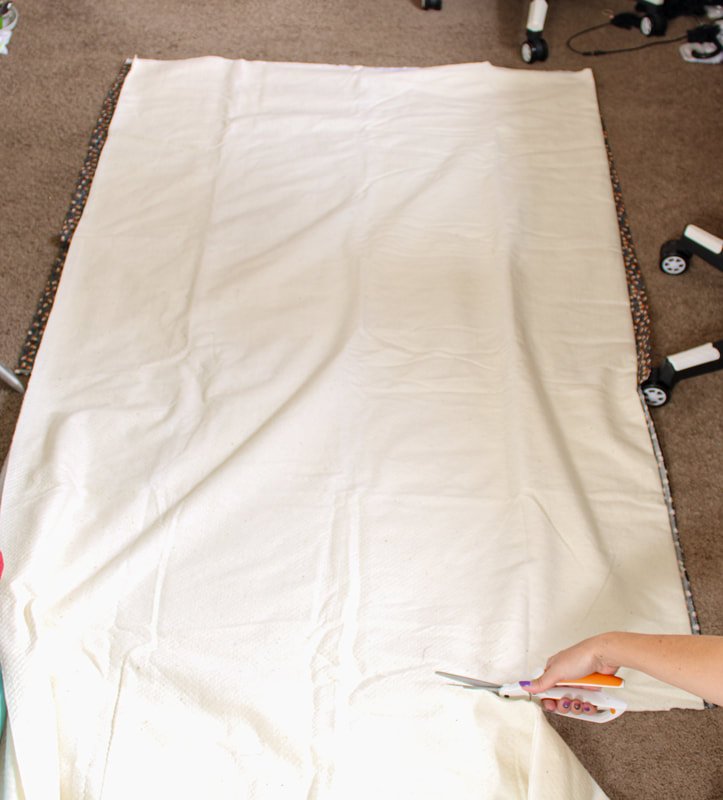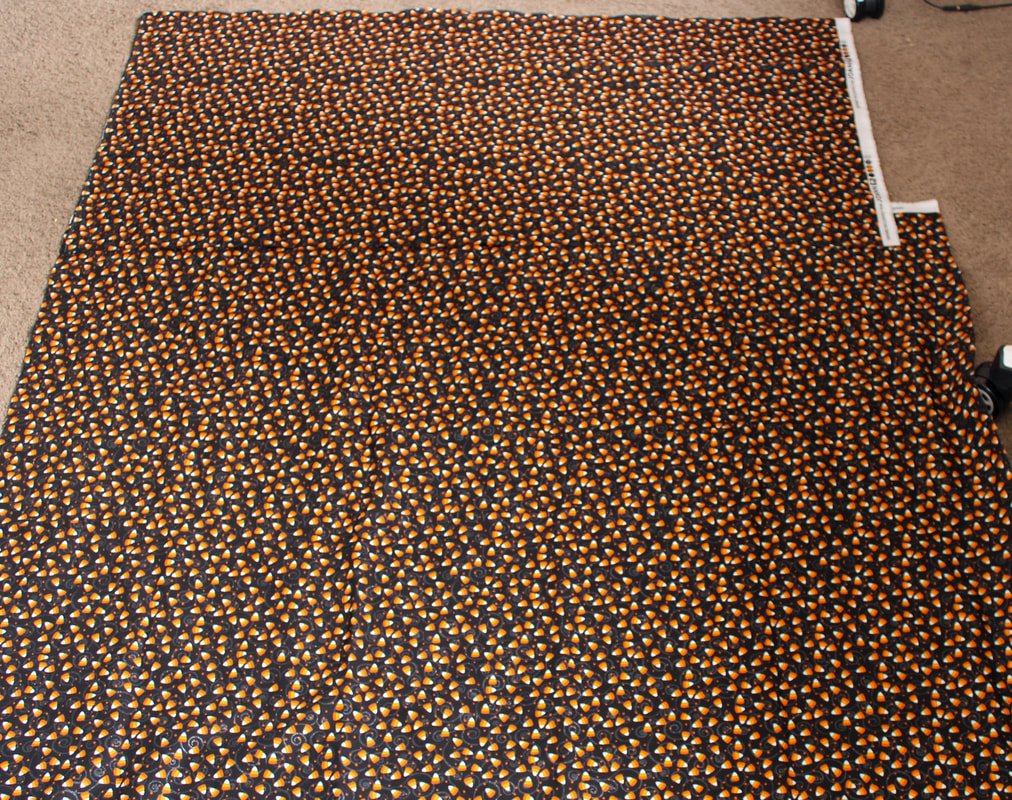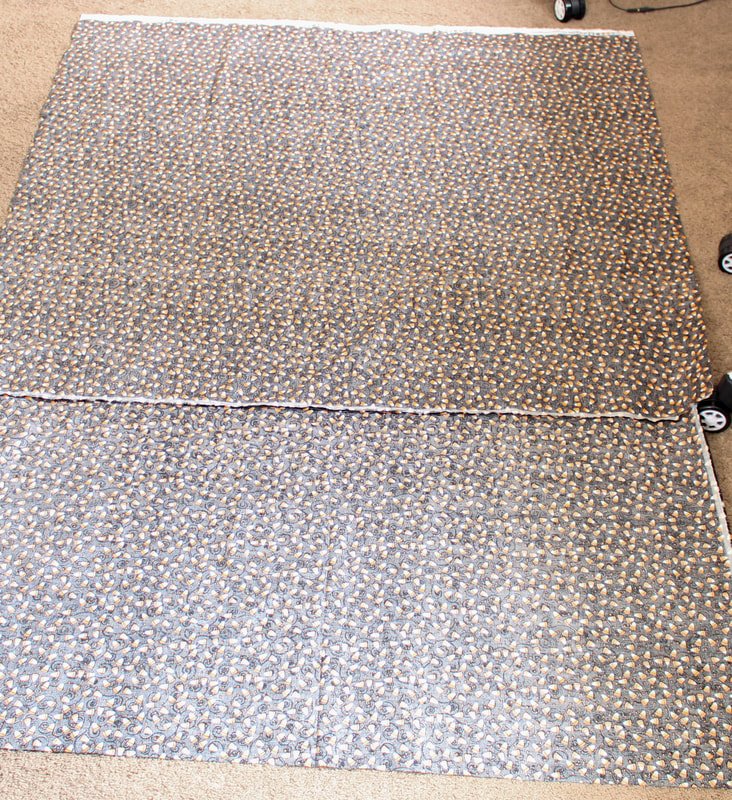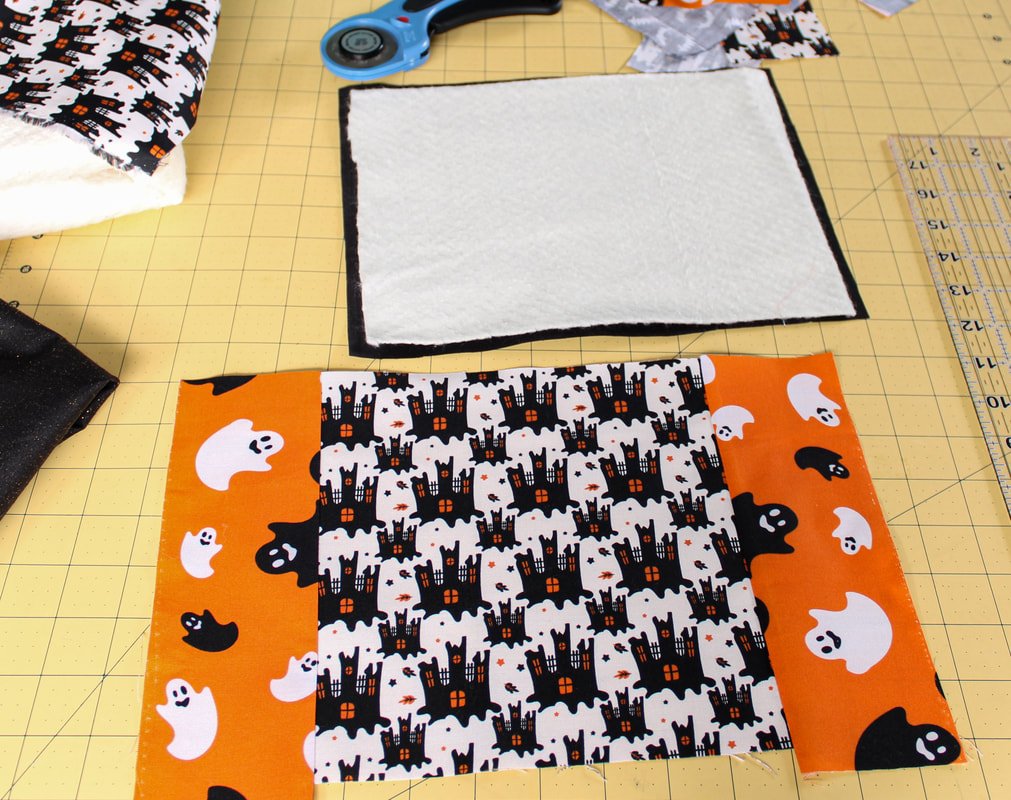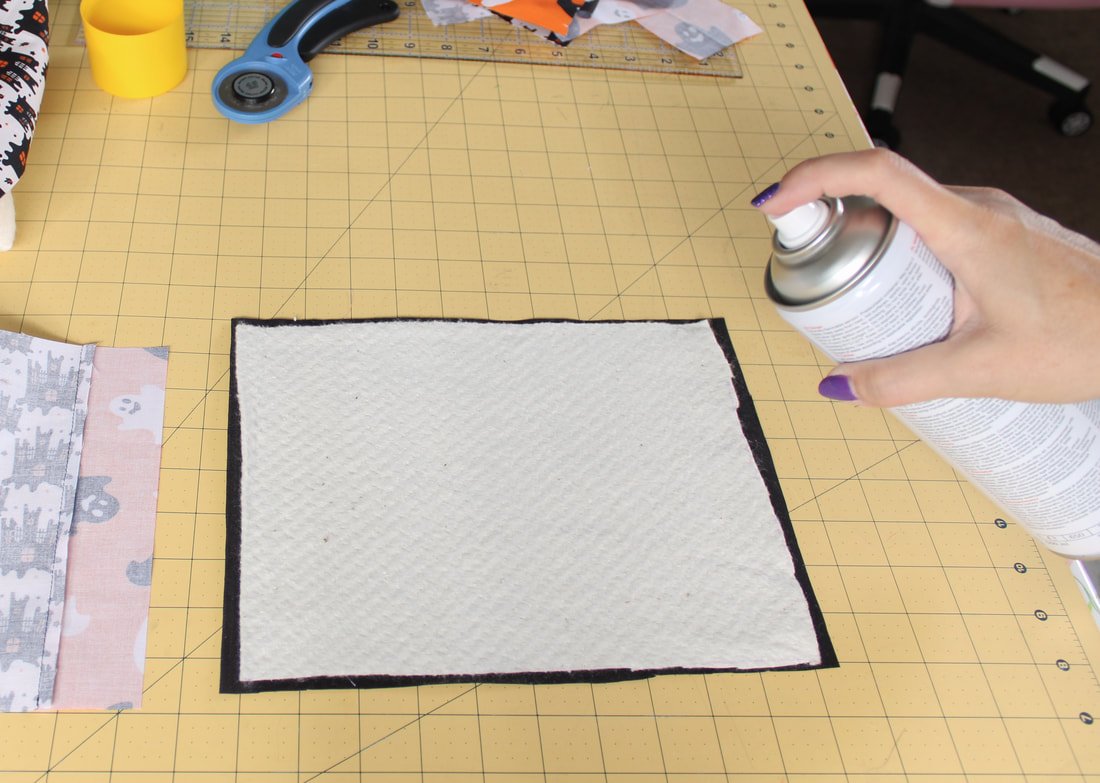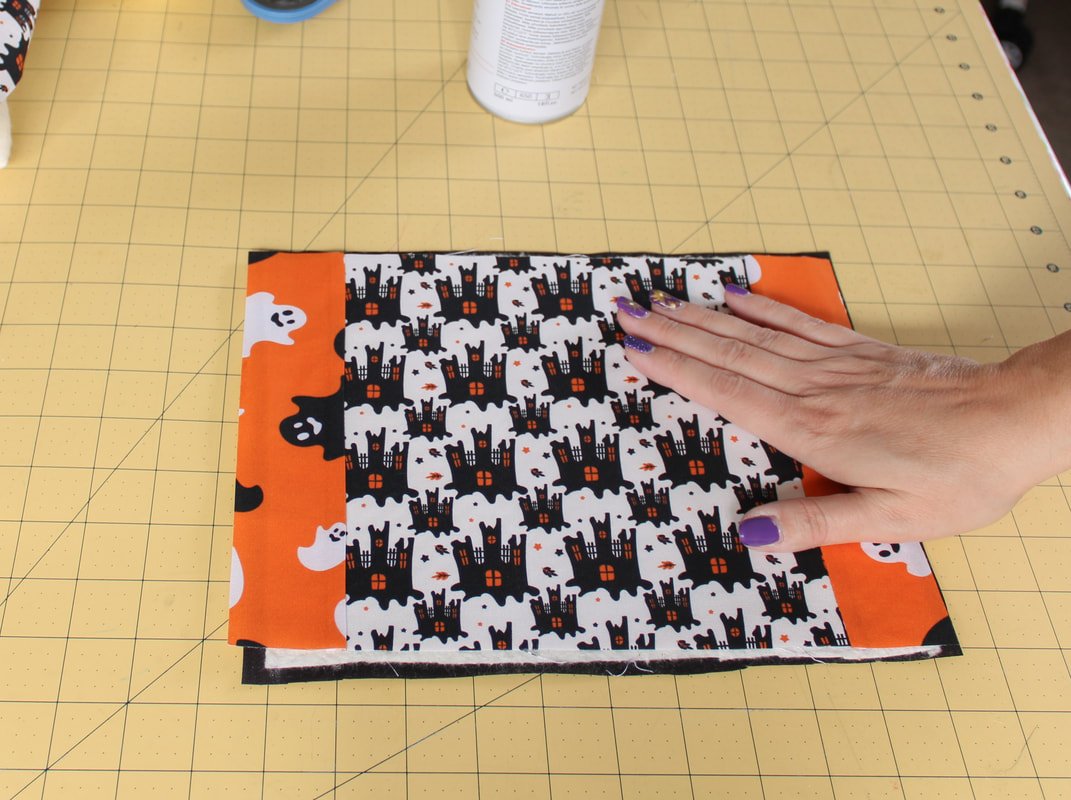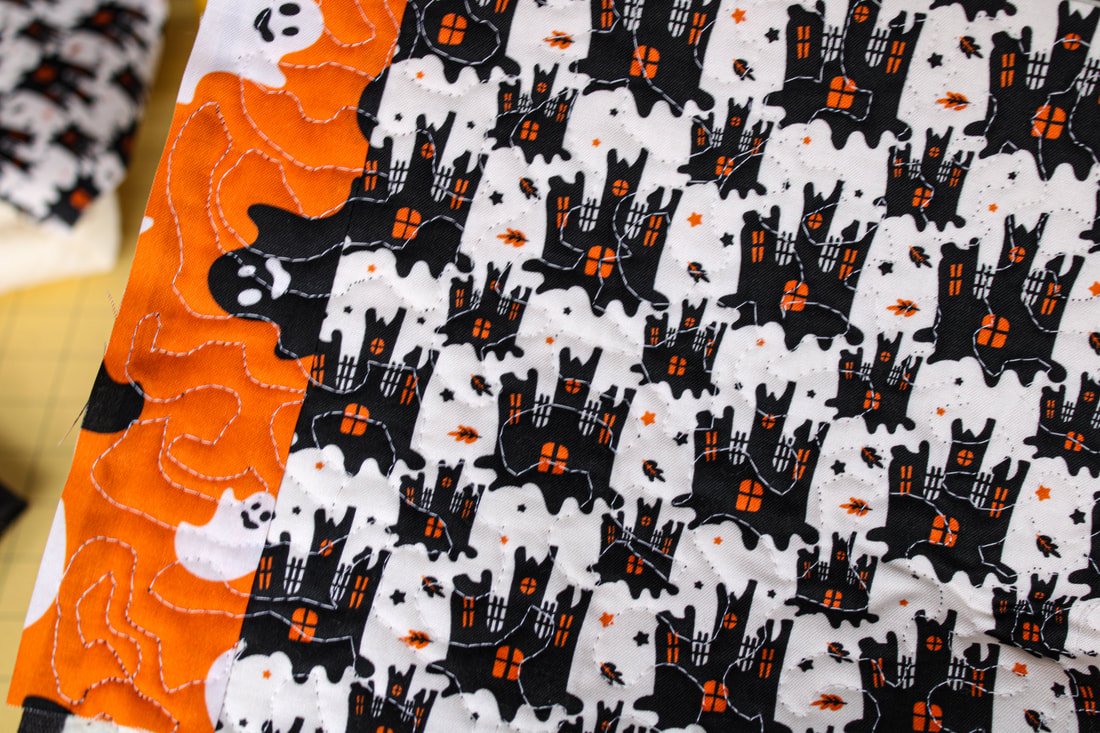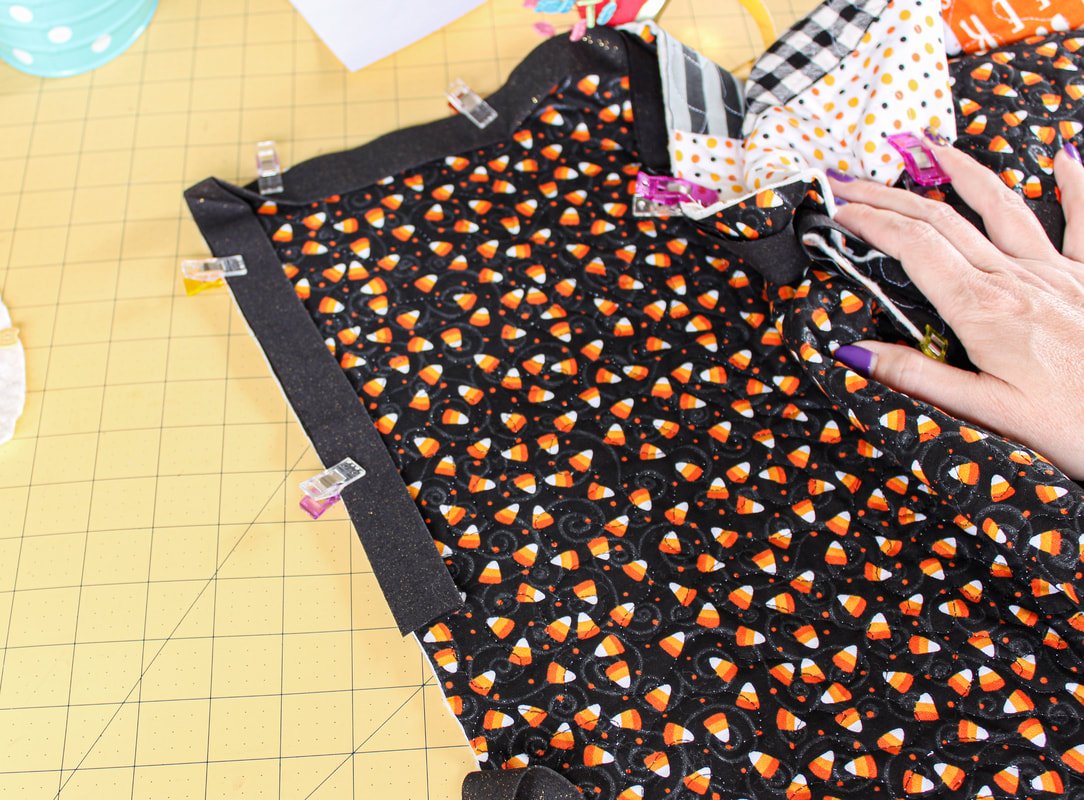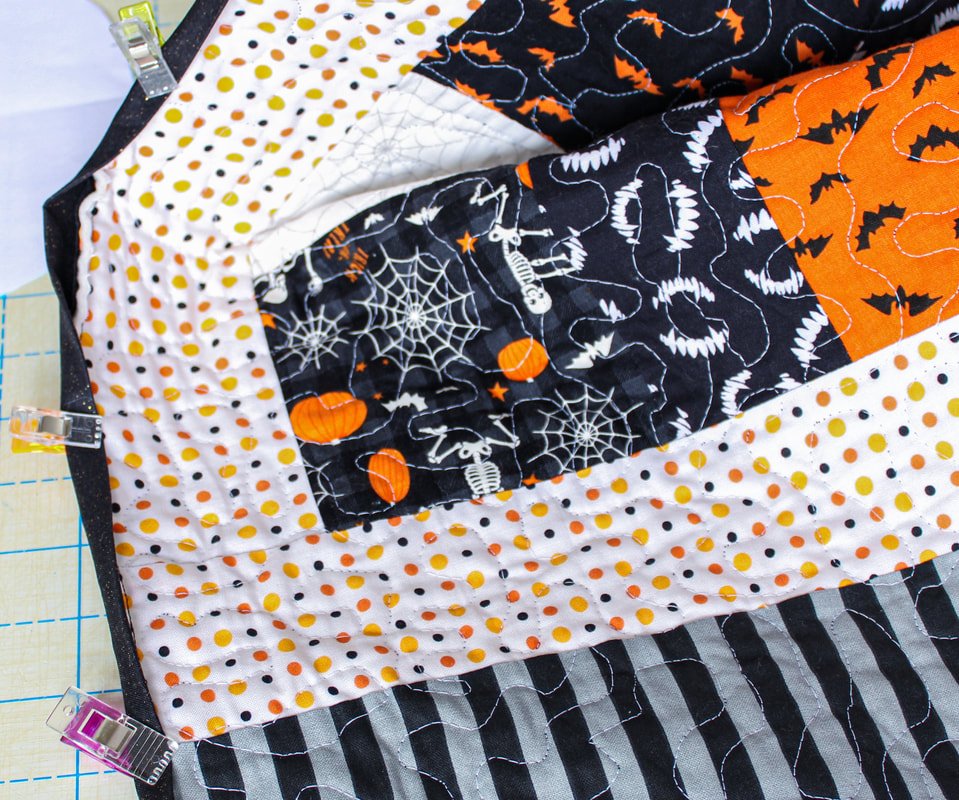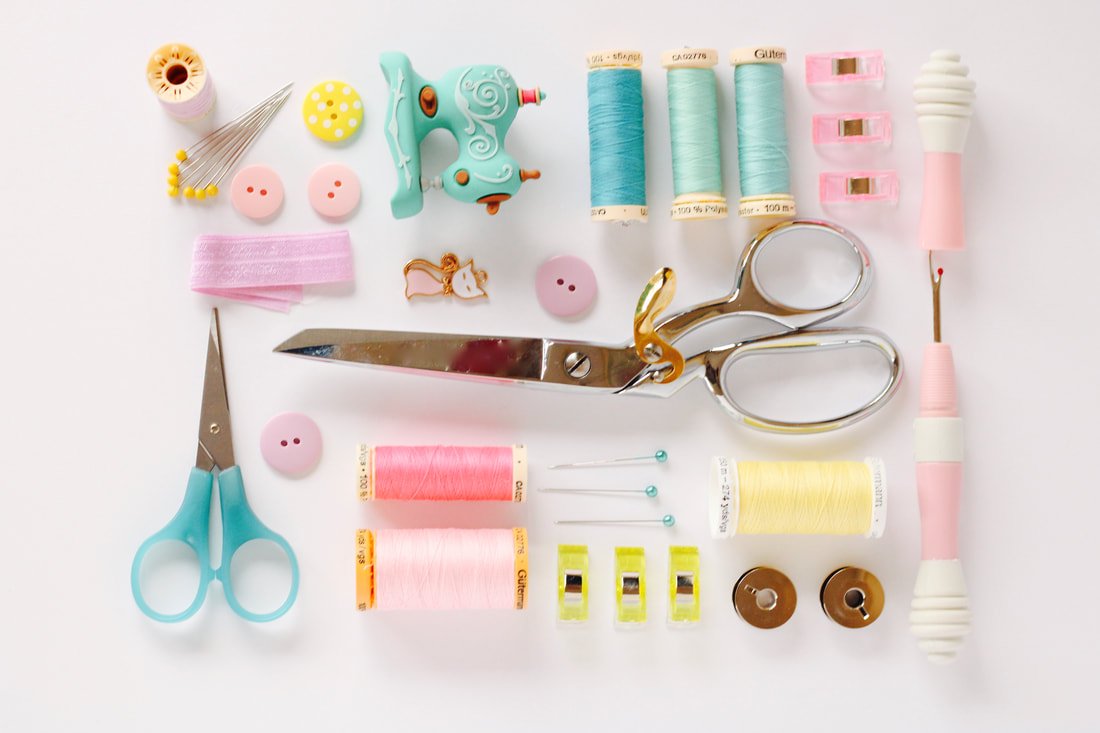
Pattern Reviews, Sewing Hacks, Tips & Free Patterns
Sewing Blog Besties
A Photographer Skirt
Sew an easy skirt. No zipper needed! It has an elastic back and flat front. It’s cute and comfortable. Add some pockets too!
Camera fabric for a new skirt.
If you’re anything like me, you have many hobbies and interests. I love sewing, gardening, farm animal-ing, photography, cooking (sometimes, ha!), and Netflixing. As a photographer who sews, I have the skills to make my clothing in exciting prints that speak to me.
Novelty prints are my favorite. So, when I saw this fun camera fabric at Hobby Lobby, I bought the remainder of the bolt. I planned on making a skirt and hoped I had enough left for a few other small projects. Hint: I’m going to make another bag using leftover pieces.
This tutorial is super simple. We’re going to make a gathered skirt. It requires 2 yards or less of fabric. Since “Cove Cove,” aka the 2020 pandemonium, I’ve gained a few pounds. Elastic waistbands are my best friend, so I made the waistband with elastic in the back. The front has a flat waistband. Business in the front, party in the back!
Interested in making one? Let’s go.
What You Need:
2 yards of fabric
1” Elastic, measuring half the width of your waist, plus 1” for overlap
Matching thread
Sewing machine
Scissors, a chalk marker, ruler, etc.
Pins or clips
Safety pin to thread the elastic
Measuring tape
Pencil and paper to create your pattern
Scrap fabric for pockets
Pocket pattern piece
Pockets
If you don’t want to self-draft a pocket piece, here are a couple of easy ways to find a pocket pattern.
Grab a pocket piece from another sewing pattern you already own. Most skirt, dress, and pants patterns usually have a pocket. Check your envelopes to find an in-seam pocket pattern piece.
Look online for a free PDF one. A quick Pinterest or Google search will give you lots of patterns.
Cut 4 pieces from some matching or contrasting fabric scraps. Sometimes it’s fun to have colorful pockets. Use solids, patterns, polka dots, or cut animal print fabric for your pockets. Make it fun!
Pocket pattern and yellow fabric for the pockets.
Skirt Instructions
Measure the length from your waist to your leg (calf, above, or below your knee) that you want your skirt, then add 2-4” for a hem. I wanted to make mine 20” long. So, I cut my fabric 22” long. I used quilting cotton that was roughly 44” wide. I cut my fabric 22” by 44”.
Cut 2. This will be your front and back.
My waist is 35”, so this created a lightly gathered skirt. If your waist is larger, you will have less gathers. If you like lots of gathers you might need more fabric. If your waist is smaller, you will have more gathers.
Pinning the pockets to the front of the skirt.
I measured 1.5” down from the top and made a notch. This is where you want your pocket to be placed. This is customizable, depending on how tall or short you are.
Pin the pocket RST to the front of the skirt. Then sew using a 1/4”-3/8” seam allowance. Press open. Repeat on the other side.
Do the same for the back skirt piece. You will now have two pieces that look like rectangles with floppy elephant ears.
Place front and back pieces RST, and pin the side seam starting at the bottom, going around the pockets, and up to the top. Sew in that order, sewing around pocket pieces. Use a 5/8” Seam allowance.
As an extra precaution, I do a few extra back-and-forth stitches at the corners where I pivot for my pockets.
I chose yellow pockets to match the branding for my photography business. I usually wear this skirt when I have a vendor show or meet a new client. It’s a fun conversation piece.
Sew around the pinned pocket. It will get pressed and tuck away nicely within the skirt seam.
You inseam pocket should look something like the one below. Yes, I used the selvedge of my fabric and we all know that’s a big no-no. Shhh, don’t tell anyone.
The pocket is tucked inside nice and neat.
Secret yellow pocket.
Gathering your skirt.
Sew 2 rows of stitching along the top with a 5-7mm length. Pull to gather the skirt. Go slowly so you don’t break a thread.
Waistband Fun
Time to sew the waistband. This part is a little more tricky than a regular waistband. You’re going to gather the back with a piece of elastic while leaving the front flat. It gives a nice look while adding comfort.
Cut the front waistband strip half your waist measurement, plus 1” for seam allowance. If your waist is 30”, cut the piece 16”.15”+1”=16”. Use a 1/2” seam allowance for the waistband. I like easy math.
I made my waistband 2.5” tall, this is completely customizable for you and what you want.
Example: Cut 2 front strips 16” wide by 2.5” tall.
Add interfacing to one strip, this will be the outer piece.
Sew right sides together, along the top long edge, only. Press open.
Making your waistband.
For the back waistband piece, you’ll cut 2 strips the same height, 2.5” (or your preferred height) by the fabric width measurement.
I cut mine 2.5” by 35”. The width can be fudged a little here, it’ll be gathered anyway. Sew along the top with the 2 pieces facing RST, just like you did with the front waistband. Press open.
Pin and sew the short sides of the waistband pieces together, creating a super-duper long loop. Press the seams open.
Pin the waistband to the skirt gathers, starting at the side seams.
Pin your waistband strip to the skirt along the gathered top.
Pin at the side seams first.
Then, pin the front waistband piece along the front skirt.
Fold the back piece in half and mark it with chalk. Pin that to the center back of the skirt. This can be finicky because you’re pinning 2 gathered pieces to each other, go slow and it’ll work out. Use lots of pins or clips.
You can hand sew the waistband- which is the correct way but, hand sewing is not my favorite thing. I turn the edge under on the inner waistband and pin it from the outside, making sure I catch the seam.
Pin from the outside and remove the pins as you stitch in the ditch.
Tricky Part of the Waistband
Stitch in the ditch when sewing the waistband. This means keeping your needle in the area where the waistband and skirt meet up. It’s a hidden stitch.
Make sure to leave a 2” gap in the side seams for inserting your elastic.
Use a bodkin or safety pin to insert your elastic.
Use a safety pin or bodkin to insert your elastic into the waistband. Insert through one open side seam.
When you get to the other side, stitch over the side seam to lock the elastic in place. Repeat on the other side. Gather back fabric evenly, then stitch to close the openings.
You are “locking” the elastic in place by sewing over it, on the side seams. The elastic will only go in the back of the skirt.
The front looks nice and flat, the back is gathered for comfort.
Closer look at the gathered back waistband.
Front waistband is flat.
The hem is the easy part. Fold your hem up however much you want1-2”, then press, then fold up again 1-2”. Pin, and stitch using a 3-3.5mm stitch length. I chose to do a shorter hem here, but I usually do a 2” hem.
I love my skirt! I made this to wear when I have events for my photography business. I usually pair it with a yellow top to match my branding. It’s simply perfect!
What do you think? Do you plan on making a skirt with elastic in the back? I call it a mullet skirt. Business in the front, comfort in the back. LOL
Happy sewing,
Annette
Back of the skirt hanging on my dressform.
Front of the skirt on the dressform.
Simplicity 1587 1940s Vintage-Style Dress
I love my newest 1940s dress made with the Simplicity 1587 pattern and fabric from JoAnn. It has an authentic feel and style to it.
Howdy doodily! It’s been some time since I last wrote a blog post. I do have an excuse though, I had to switch platforms from one host to another and that was soul-sucking in itself. Then, I decided to update each and every blog post. Why!? Why would someone do that? Annnd, after that was all said and done, I enrolled in another photography class at the local college- which was brain cell killing as well. Oh, and to top it all off, I thought it was a good idea to open up a photography business. Yep, I’m officially a photographer now. I do portraits. I’m not your typical portrait photographer though. I create photos with magic and whimsy in them. If you’re in Southern California (or Monterey County, where I often travel) and are interested in photos, or know someone who might be, I invite you to check out my site. Whew! It’s been a huge whirlwind but, I’m finally hopping back into the sewing life. So, here we go!
Let’s start with a dress I made 1.5 years ago. I needed a dress for a friend’s wedding in San Diego. I wanted something with a 1940s feel to it. I had a pattern and bought two different fabrics. I loved the pattern so much, that I wanted to make two dresses. Spoiler alert: I didn’t end up making my first pattern choice.
Cue the Rabbit hole of sewing. And, patterns. And, muslins.
The First Dress
This dress was made in a short amount of time so, I didn’t photograph the whole process. This blog post is more of a “this is my dress I made” rather than a tutorial on how to make the dress.
I started with a Sew Over It dress pattern I had in my stash for years. Years, I tell you. I made a muslin and did a FBA and it didn’t fit. I thought I did something wrong, and made a whole new FBA and muslin. Nope, it still didn’t fit right. Something was way off. I went to the trusty ole Youtube and Google machine and found that most sewists had a similar issue. It fit funky. So, I went back to the drawing board and pattern rabbit hole.
The Final Dress
I discovered the Simplicity pattern and snagged one in my size range at ye olde JoAnn. I made a quick bodice muslin and it fit! So, I whipped the dress up in less than 24 hours. Ha! I told you I needed it for a wedding. This is the first garment I’ve ever sewn in a short time frame. I finished it minutes before leaving for the wedding.
The only issue I had was the yoke. Yokes can be finicky sometimes and this was no exception. I sewed it and ripped it out a few times. In the end, I didn’t care about the puckers anymore. Shhh, don’t tell the sewing Gods.
It has an easy pleated neck tie, gathered sleeves, a drop waist, and is comfy. It’s not the most flattering or form fit, however, it does look like a true 1930-1940s vintage style dress. I paired it with some 1940s-style booties from Payless Shoes Source, RIP. Looking back, I wish I had worn some different shoes. But, San Diego along with all of southern California was getting dumped on by all the rain in the world that weekend, so boots were worn out of necessity. Puddles and ballet flats don’t pair well.
Ignore my 2 different shoes. I was deciding which one to wear and forgot to change before taking some photos.
Awkward pose and view of the cute necktie.
Look at the easy gathered sleeve. You make this with a small piece of elastic.
The cute peephole button in the back. I love this dress! The button is a burgundy covered button I had in my button jar.
Hope you give this dress pattern a try if you’re searching for an authentic 40s-style dress. It is easy to sew and fits well.
No, I never did make the second dress with my other fabric (both were purchased from JoAnn). Maybe that’ll be next up on the sewing table, right after I finish a new purse, more flared shorts, and wide-leg trousers. Ha!
Please share in the comments your favorite 1940s dress pattern. I’m always on the lookout for new ones.
Thanks for popping by,
Annette
Sewing A Barbie Dress
Hi Barbie! Sew your own Barbie dress with Gertie’s new Barbara Bodice pattern from her patreon. It’s an updated B6453 version. Pink and white gingham fabric and this pattern created a replica of the barbie dress from the movie.
Hi Barbie! Have you noticed the pink phenomenon that is spreading all over the world? It's a whole Barbie craze! And, I'm here for it. Gimme aaallll the pink. Have you seen the movie? I saw it twice. I made a dress and had to share it with you. Yay for Barbie sewing!
Barbie Dress. Check! Pink fuzzy slippers. Check!
I grabbed the Barbara Bodice pattern from Gertie's Patreon. If you aren't a member, run, don't walk, and join now! She gives so much over there, even at the base level. The Barbara bodice is the updated version of her original Butterick 6453.
This isn't a sew-along, but it's more of a show and tell. I want to show you the Barbie movie-inspired dress. If you've made a Barbie dress, shorts, PJs, or other inspirational item, tag me. I want to see what you made. I've seen a few goth Barbie outfits that are super fun too.
Let's dive in!
Feeling fabulous!
Barbara Bodice
My thoughts on the Barbara bodice might not be the popular opinion. But, I much prefer the Butterick 6453. I like how the back fits me. It has a simple dart. The Barbara has a 2-piece back pattern. It's fine enough, but seems to be extra.
Barbara has different cup sizes, which is awesome!! No more figuring out your FBA. For the busty gals, this is a huge plus! However, my bodice didn't fit, as flawlessly as the Butterick 6453. I had some extra armpit room, which is weird. I like the FBA I created for the Butterick pattern better. I plan on making another Barbara (I didn't make a mock-up for my Barbie dress) and I'll play with the pattern, fit, and sizing.
Gertie included 2 strap options with the Barbara Bodice. Self-tie straps that are thin, and wide gathered straps, for bra strap coverage. I opted to use the thin self-tie straps, and they covered my wide bra straps well enough.
The Barbara doesn't have any facings, it's fully lined, which I'm a huge fan of! I definitely love the pattern and am a huge fan. Both the Butterick 6453 and Barbara come together so easily and are fun to sew. It's the perfect last-minute dress pattern. But, I'm still on the fence if I'm over the moon happy with the Barbara.
Have you sewn it? If so, have you compared the two patterns side by side? The general consensus I've seen across the interwebs is that the Barbara is wonderful. But, as I've gone down the pattern-making black hole, I've become more of a pattern snob kabob.
Thinner straps that you can tie into a bow. Easy and cute.
The new scoop back is pretty too.
Skirt Stuff
Gertie also created the Barbie movie skirt pattern to go with the bodice. It's a full box pleat skirt that uses aalll the fabric. When I ordered my fabric, I ordered 4 yards. However, the skirt alone uses over 4 yards. So, I went with plan B.
I opted to draft my own circle skirt, and of course, I added roomy pockets. I actually prefer circle skirts over gathered ones anyway. I have a fuller tummy and appreciate less fabric in that area. Plus, circle skirts are just fun!
I've been learning pattern making as I mentioned above, and I'm taking it one step at a time. If you're interested, check out Tricia, she's the best teacher! And, her motto is "You don't need to be good at math for pattern making". Which I'm all about because mathing is hard. Haha :D
Self drafted circle skirt.
Welp, that's it. Do you love the dress? I sure do. I feel so girly in it and it'll be a February staple as well. I plan on wearing tights and a sweater, or a long sleeve underneath it.
Not a Barbie fan? You can sew a 1950s-style swimsuit instead. It's the Bombshell and it's flattering on everybody.
Have you ever been interested in making a quilt? Read my blog post and you can sew one up in about a week.
Thanks for hanging out today. Happy sewing of all things pink!
XOXO,
Annette
New Look 6446: Sewing Fail
New Look 6446 sewing pattern. This was a sewing fail because I chose the wrong fabric. Sewing is a journey and sewists are constantly learning. After 20+ years of sewing, I still make mistakes.
Sewing is a journey. Whether you've been sewing for a few months or decades. As sewists, we are constantly learning. We have ups and downs. Recently I took a jump and disregarded a golden sewing rule. Yep, I had a sewing fail. I've been sewing for over 20 years and you would think with that many years under my belt, I'd be a super pro. Nope, not the case.
I started with a pattern I've made before. The fit is good but, I went rogue! I used knit fabric for a woven pattern. And the outcome was, well, all kinds of wrong. Here's why you stick with the fabric that the pattern recommends.
Choose your fabric wisely. When you pick a sewing pattern, the envelope gives you lots of important information. Do not ignore it. Read the fabric recommendations and stick with them, for the most part. I made my first New Look 6446 pattern back in 2020 with a stretch cotton sateen. It turned out beautifully. I wear it all the time and love the fit. I wanted to make another one and figured since the last one turned out, I could use knit fabric for a second one. It would be the ultimate cozy secret pajamas. I was wrong!
I followed the directions to the T. I even followed the layout instructions after I had made a mental note of my directional fabric. The back legs ended up getting cut upside down. Womp womp. Nevertheless, I carried on.
Sewed the darts on the front and back bodice pieces.
Added the interfacing to the top piece. At this point, I started to realize I had chosen the wrong fabric. the knit didn't like being sewn in this direction. But, I kept going.
The pocket bags sewed up nicely. This pattern has such nice roomy pockets. I love it!
Legs are sewn together.
Pant legs went together easily. I realized I sewed them with upside-down fabric afterward. So far, the only wonky part is the bodice.
Sewed up the crotch seam. I was getting excited because it was coming together nicely.
Pinned the bodice piece to the legs at the waist and sewed. I did notice a little stretching at this seam but thought it was no biggy. Secret pajamas remember!? This is going to be so cozy!
Next up was the invisible zipper. I love sewing these. It feels so wrong the way they go in, but it looks so right after they're in. I buy mine in bulk, so it was either black or white. I chose black, but wish I used a white one. Ah well.
I didn't take photos of the lining, but it's the same as the bodice. It was all stretched out. I attached the shoulder straps and hemmed the legs.
I tried it on and it fit. It fits with tons of extra room! Not good. It's not a baggy-style jumpsuit. It's supposed to be more form fitting. Ack!!
Where I Went Wrong
I chose knit fabric for a woven pattern. Not smart. The amount of ease and sewing pieces were created for a nonstretch fabric. When I made my first one, the fabric had a slight stretch but, wasn't knit. Lesson learned.
I laid my fabric out with the direction in mind, but then left my brain in the kitchen and placed the pattern upside down. So, my back pant legs are upside down. Face-palm, lesson learned.
The rippled top piece was interfaced with stretch interfacing. Not sure if this was a good or bad move. I think it was a bad move perhaps? I also think I should have made the lining with a woven fabric. It would have acted as a stabilizer to keep the knit fabric from stretching out.
Fixables
Armhole sagging, gapping, bagging. I will unpick the waist seam and take a "dart" out of each side seam. This will hopefully eliminate the baggy armholes.
I'll take in the waist seam a bit too, it's on the too big side.
A Positive Side
I learned my lesson on fabric choice. I thought I'd be able to get away with using a different fabric, but learned that I, in fact, cannot. I'm glad it was a silly mistake that I can fix. I still love the jumpsuit and plan on wearing it for three seasons. It's super comfortable and looks cute. The upside-down fabric on the backside doesn't bother me as much. The print is small enough that nobody will even notice.
It’s a wonky green thing, but I wear it often. It’s another secret pajama outfit!
What's your most recent sewing fail? Or sewing win!? Let's celebrate both today!! Comment below.
Happy sewing!
Annette
Making a Quilt, the Easy Way
Make a quilt the easy way! Follow this tutorial and choose your own quilting adventure. Squares and strips make for an easy and customizable quilt. Cut each piece as big or little as you’d like. Free-motion quilting isn’t scary. It’s fun and easy if you take your time and go slow. This is a great beginner-friendly dive into quilt making.
Cooking is fun, messy, and can be very delicious. Gardening is quite rewarding because its fun to watch things grow. Sewing, however, is my main jam! I love making bags, gifts for others, clothes, and so much more. Sewing is definitely my most beloved hobby. However, I was never a fan of quilting. To me, quilting and sewing are two different hobbies. Are you team sewing or quilting?
I never loved making those strip pieced table runners, or small quilts. Too many rules to follow. Too many tiny pieces of fabric to cut. Cutting all of those small pieces to then sew them together again, is my absolute nightmare. But, something wild and crazy happened during this past Fall. A Halloween quilt came to life! I don't remember what planet I was visiting, but I decided to make a quilt. Spoiler alert, I made a Christmas one too. And, I loved every minute of it. It was so much fun! Why did I change my mind? Well, I didn't follow a pattern. I did my own thing entirely and loved the process and final result.
If you're not a quilt fan, I beg you to try making a quilt following your own rules. Read along for some easy tips to create your first (or next) quilt. Am I a quilter now? I don't think so. But, I did enjoy making both of the holiday lap throws. As you read, you'll notice more of the Halloween quilt. I took more process photos of that one but, there are some Christmas ones too.
Disclaimer: I am not a professional quilter. I probably do some cringe-worthy things here but, this is how I made my two quilts. The best part? I didn't want to set them on fire in the process. Sewing is supposed to be fun and not stressful. And, after all, it's just fabric and we all own a seam ripper or two. Let's get quilting!
Supply List:
Fabric. Lots and lots of fabric. 1-3 yards for the backing. 2-3 yards of various coordinating colors, patterns, and styles of fabric. It might be easier to start with 4-5 different fabrics first.
A package of batting
Quilting rulers
2-3 Spools of thread
3+ bobbins
Quilting Gloves (I use Grease Monkey auto ones)
KK-100 Spray adhesive
Free motion quilting foot
Patience and lots of snacks
All the Fabric Pieces
A quilt is a fabric sandwich, more or less. You have a top, which is all the pretty pieces. The middle is the batting layer. The bottom or backing is the fabric on the back. It is usually a solid or printed piece. If you make a larger quilt, you'll need to have a seam or two running along the back.
First, decide on the size. Are you making a table runner, or a lap quilt, or going for the gusto and making a Queen bed-sized one? You don't need to stick to this exact size but, a general idea is good. Keep in mind the size of your backing as well. Quilting cotton comes in 44" widths so unless you want a seam or two running down the backside, you might want to keep it smaller.
Next, you want to decide on shapes. Do you want rectangles, thin strips, squares, or more intricate shapes?
You'll need to also include border strips. These will frame your inner quilt pieces. Traditionally, you add these to the sides first, then the top, and then the bottom. However, it's your quilt. You have my permission to make it however you want. Go ham!
Be sure to choose similar colors or patterns. For a first quilt, it may be easiest to purchase fabric in the same design family. That's what I did for the Christmas one. The fabric was all made by Singer and I bought it from Michaels.
Decide on a rough layout, it doesn't need to be set in stone, it's just to get you started. Then cut the pieces using a rotary cutter, mat, and ruler. Example: You can start out by cutting 10 pieces of red, 10 of yellow, 10 of blue, 10 of checks, 10 of polka dots, etc. You can always add more or take it away. This just gets you started. You can also buy a set of pre-cut squares to make it even easier. Set each pile aside. You'll work from the piles.
*For reference, I'm going to use my own lap lap-sized quilts I made, which were roughly 4'x6'.
This Halloween one has squares and long strips.
The Magical Layout
This, in my opinion, is the most important part. Yes, crooked seams want to be avoided along with wonky stitching but, the fabrics need to look pretty. So, this step is very important.
Clean off a huge area on the floor and start laying out your pieces. You usually want it longer than wider but, again, your quilt.
Lay the squares down in a rough pattern. For my Halloween one, I did 6 across, and 7 down. I didn't want the same colors or patterns touching. This can be impossible sometimes. Switch them around until you get something you like. If you're losing your mind over this part, walk away and come back later. It can also help to have a second opinion. Ask a family member, text a photo to a friend, or DM an Instagram bestie to ask for their opinion. I even found that just taking a photo and looking at my quilt in the photo helped me fix a few snafus. Call me crazy, but the layout can make or break your quilt. I've seen some less desirable ones that could have been saved by a different layout.
I decided to make my quilt larger than my original planned size. To do this, I cut 3" wide strips the length of my top piece, and sandwiched them vertically, between the squares. This is easy to do and it can make it longer or wider. After you stitch all the small pieces together, your quilt shrinks quite a bit. Who knew a 1/4" seam allowance was so big? Haha
Place your long border strips on the top and bottom. They frame your quilt and "seal the deal", so to speak.
Most machines come with a quarter-inch sewing foot, have marks on the machine plate, and some might even have a quilting guide bar. Make use of one or all of these.
Use a 1/4" seam allowance at all times, for all the pieces. It might seem small but, it creates less bulk. You don't trim the seam allowances like you would in garment sewing.
Use cotton or polyester thread. I used polyester. I've honestly never sewn with cotton thread. You'll have to do your own Google search on that if you're interested. (I think purists use cotton thread but, I could be wrong. Again, not a professional).
Start by sewing the first vertical row from left to right. You'll sew the squares to form a really long strip.
Press each seam to one side. Don't press open like you do with garment sewing. For example, press each seam to the left side in this row.
For the second row, sew all the squares (or strips) to each other the same way you did with the first row.
Press each seam to the right side. Give a quick press to the front side of the seams too.
Sew the second row to the first row making sure to line up the seams perfectly. Press seams to one side.
Repeat this until you're at the end of the length.
If your quilt is easier to sew the strips/squares across, do that and work your way down.
You could use a walking foot to sew your pieces if you'd like. It helps to "walk" both layers evenly at the same time. I used the quilting foot my machine came with for the Halloween one. For the Christmas one, I didn't. Both turned out beautifully without issues.
After the middle portion is completed and you're standing in shock and awe at the small sized quilt, you might want to make it bigger. I know I did! Ha! I still can't believe how much it shrinks after sewing all the pieces together.
If you'd like to make it bigger, you can sew a few extra strips to add to the sides, top, and bottom. In that order. My Halloween quilt shrank after I sewed the middle area together. I didn't realize how much a tiny 1/4" seam allowance would eat the fabric.
Sewing the Pieces Together (in photos)
Halloween Quilt
This is the finished top. You can see where I added length with wide strips at the top and bottom. I created a thin strip border to add width as well.
Christmas Quilt
This is the Christmas quilt top. I love the red and aqua color combo. I used thin strips on the sides, top and bottom. I love how this one turned out.
Batting (the middle layer)
Batting is the layer that gets sandwiched between the quilt top and the quilt backing. This is not the fluffy layer your grandma or great-grandma made your baby quilt with. This is a thin layer that has some weight to it. It's easy to sew through and adds heft to your quilt.
**You want to cut your batting piece a few inches bigger than your top and backing pieces because it can shift during quilting.
There are lots of different types of batting, including that fluffy layer Grammy made your baby quilt with. Use it if you'd like but, I wanted to share some other options.
The old stuff is 100% polyester and is on the thicker side. It has a habit of falling apart and clumping after a few washes. It's very inexpensive and it shows. Use at your own risk. Can you tell I'm not a fan? Haha
100% Cotton batting. This is my preferred batting. I only buy this kind of batting. It comes in different sizes, colors, and weights.
Cotton/Poly blend. It can be the best of both worlds. Or, the worst. ;)
Here's an in-depth blog post all about battings. It has the pros and cons of the different types. You can make your own decision on what type you want to use.
Bonus tip: buy a larger size than you think you need. You can get a couple of smaller quilts out of one package. And, use the large scraps for bag making.
Last Layer
Now that you're ready to add the last layer, you'll want to grab your spray adhesive. I prefer KK-100.
Lay your backing down on the floor, wrong side up.
Then, add the batting on top. If you use the cotton type, the seedy-looking side goes up.
Then place your beautiful top onto the batting, right side up. It's a quilt sandwich.
Now, there are different ways to go about this next step. Some people prefer to use safety pins to hold the layers together. I found that spraying each layer with KK-100 spray adhesive worked perfectly. It held the layers together and I was able to quilt over everything without any issues. I have a video of how I did this on my TikTok and Instagram reels. @Sewingtothemoon
I started by spraying the bottom layer while having the top layers rolled up. I'd spray about 6" down, across the whole top, and then roll the top layers down. I proceeded until I got to the bottom. Then, did it again for the top layer. Smoothing everything down as I went. It helps to watch the video to get a better idea. This whole process takes about 15 minutes or so.
You can use safety pins instead if you'd like. You just pin every so often through all the layers. I don't use this method, but a quick Google will show you how to use the pins.
The fabric didn’t fit, so I ended up sewing 2 pieces together.
Peanut Butter Quilting Time
I couldn't help it, I have the song Peanut Butter Jelly Time stuck in my head.
Do not use peanut butter for quilting! Haha. Could you imagine? Ack!
Now that your layers are securely together, it's time to actually quilt. There are so many different ways to go about this. Quilting is the top stitching that keeps all those layers together. And, after you wash it the quilt puffs up between the stitching creating a beautiful heirloom piece. It gives life to it.
You can drop your quilt off or mail it to a quilt shop/company. They quilt it for you for a fee and then send it back to you. This can be expensive. However, they have quite a few stitching designs to choose from, and it will give your quilt a professional look and feel.
You can sew straight stitches on each side of the seams. This is a simple and painless way to quilt. You could also stitch in the ditch.
Free-motion quilting is another option. Your machine may or may not be able to do this. If your machine can do free-motion, it will have a special foot for doing so. You will need to set your feed dogs to the lowest setting. Check your manual for all the settings, every machine is different. My sewing machine can do free motion, I did a short simple review of it here.
I chose to free motion my quilts and it was such a fun experience! If you choose this route, make a small tester quilt first. A mug rug is a good starter size.
Here are some tips:
Go slow at first, then go faster. It's a learning curve to combine the perfect foot pedal speed with the speed of your hands, to move the fabric around.
Try sitting or standing.
Keep both hands on the fabric, guiding it around and around. Stitch to the edges.
Sew in random swirls or another design and make sure to not cross over any previous stitching lines.
It's easiest to start in the middle and work in quadrants. Divide the quilt into fourths and free motion one-quarter at a time. Use a pin to mark the center.
Preload a few bobbins, it takes a lot of thread!
Use a coordinating thread color if you want to hide the stitches. You can use a different color on top and the bottom.
They sell quilting gloves for a reason. Gloves help grip the fabric as you handle it. It seems silly but, believe me, you're going to want some gloves. I used a new pair of Grease Monkey gloves that the auto shop sells, for my Halloween quilt. They worked wonderfully. I purchased actual quilting gloves and they were useless! I have a latex allergy and I bought the latex-free ones. Perhaps the latex-full ones work better? I'll never know. ;)
Some stitches will be longer and some will be shorter, don't stress over this. It's a handmade quilt after all. If you want absolute perfection, then send it to a quilting shop.
All in all my quilts aren't perfect. But, I enjoyed the process of making them and didn't stress too much. I whipped each one out in about 3-4 days. I spent one day cutting and laying out everything. One day sewing the top together. Another day spraying and quilting everything together. The last day was for finishing the free motion quilting and sewing the binding on.
Make a tester piece with some scraps before you attempt to free-motion your quilt.
Expert Tip
After you finish the free-motion quilting, go get a massage, facial, manicure, or anything to pamper yourself. It's a killer for the neck, shoulders, and back.
Binding the Edges
Last but definitely not least, it's binding time. It's the fun part! Yay! Your hard work is almost done. Soon, you'll be gifting your new handmade quilt or curling up, underneath it. The binding is pretty easy. And, unlike garment binding, it does not need to be cut on the bias. Woohoo!
Cut long strips the width you want the binding to be. There's probably an exact measurement the quilting Gods go by but, I found that I preferred a 2.5"-3" wide strip.
Measure around the quilt to figure out the length you need and add a couple of inches for overlapping.
Cut the strips the width of your fabric selvage to selvage. You may need to cut and sew a few strips together matching the short ends.
Fold in half and press.
Now, decide which side you want the binding to fold towards. I'm sure there's a right and wrong way but, I had mine folded to the back. I wanted to machine sew it on and figured if there were issues, I'd have the ugly be on the back. Ha!
To do it this way, pin the raw edges of the binding to the raw edges of the quilt top. Sew and do your best to create nicely mitered corners.
Then, flip the folded edge of the binding to the backing. Pin/clip it all down while creating nice corners.
Hand-sew the other side or run it through the sewing machine.
And... holy moly, chips, and guacamole, you're done!
The back looks like this. Sew the other side “stitch in the ditch”. Use coordinating thread. You can also hand sew instead.
My finished Halloween quilt in all her glory. I love how it turned out and I’m extremely proud.
Can you believe how easy it can be to make a quilt? Are you excited to start one now? Do you dislike quilting as much as I used to? Share in the comments below! Also, if you have useful quilting tips to share, please do so.
Happy quilting!
Annette
























